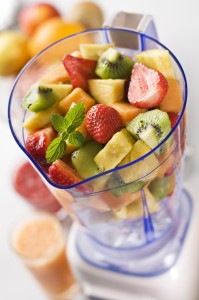To Juice or To Blend

Geri Wohl, CNC
Better Eating Coach
Written By: Geri Wohl, CNC
www.bettereatingcoach.com
Have you been hearing the buzz about juicing and wondering if you should jump on the bandwagon? Are juices or smoothies better for you? Let’s explore the differences between the two so you can make an appropriate choice based on your individual needs.
Juicing
Juicing is defined as the process whereby the liquid part of a vegetable or fruit is extracted. The extraction process removes the insoluble fiber by squeezing the pulp of the plant. The remaining liquid is an alkaline juice that is a powerhouse of vitamins, minerals, soluble fiber and antioxidants. Drinking fresh vegetable juice allows us to detoxify the body of harmful substances that may have accumulated. By drinking these juices, the body has a chance to repair the digestive tract and strengthen the immune system since the body doesn’t need to spend time and resources breaking down food. Nutrients pass quickly into the blood stream fueling our cells. If you juice, be aware that juices, especially fruit juices, are full of sugars and without the all-important insoluble fiber, blood sugar regulation can be adversely affected. For more about blood sugar, see my article, “The ABCs of Apples“. To keep sugars lower, opt to juice more vegetables than fruit. Harvard researchers have found that just one serving of fruit juice per day can increase the risk of developing type II diabetes by up to 21%. In addition, because of the missing fiber, juices will not satiate you for long; you may notice hunger pangs more quickly than when eating a regular meal. Fresh juice should be consumed soon after preparation; otherwise the health-promoting nutrients degrade upon exposure to the air. If you are not consuming all the juice, it can be frozen for later.
Juicing requires the right equipment. A good quality juicer can range from $100-$400. Furthermore, the juice will only be as good as the ingredients used. To get a full glass of juice, you need to purchase a lot of produce. For example, to make 1 8-oz. glass of juice, you would need about 5 to 7 carrots, 6 large celery stalks or 1 bunch of spinach weighing roughly one pound each. Since many vegetables are used, you can obtain your full servings of veggies and fruit per day (7-10 servings of vegetables and 2-3 servings of fruit per day are the current guidelines) more easily. Another downside of juicing is the clean up. Most juicers have many parts that all need to be thoroughly cleaned after use. Some people find this task to be a large deterrent. Remember that if juicing, regular meals should also be consumed to obtain all your nutrients. If juicing for detox, only consume a liquid diet for no longer than 2-3 days.
 Blending
Blending
While juicing extracts the liquid portion of the plant, blending uses the entire vegetable or fruit. All the fiber found in the plant is retained so smoothies will provide more energy for a longer period. Blood sugar spikes that can occur with juices are mitigated in smoothies as the nutrients are released more slowly into the blood stream. The fiber in smoothies also provides additional health benefits by supporting the digestive system, lowering LDL levels and aiding in weight loss. For more about the benefits of fiber, see my article, “Not Just Dijon“. Smoothies have more volume. As such, you won’t consume nearly the same amount of produce as you will by having a glass of juice, but they will fill you up and have plenty of the same health-promoting nutrients.
All that is needed for making smoothies is a good blender, which most people already own. Produce is still needed but not in the same quantities. For instance, if making a smoothie, you might add 7 kale leaves as part of the mix. When juicing, 7 kales leaves yields 1.5 ounces of juice. Other foods such as protein powders, flaxseeds and nut butters can be added to the mix. Smoothies can be a delicious breakfast that keeps you full and energized until lunch or a nice afternoon snack. Typically, I make a mixture that is about ½ fruit and ½ veggies with protein powder and coconut water. See my smoothie recipe on my Spring Snacks 2014 recipes page. Clean up is relatively easy and not as time consuming as with juicing.
Both juices and smoothies work on getting our bodies to a more alkaline state. The pH of the body plays an important role in keeping us healthy. Our bodies function optimally when they are slightly alkaline. To accomplish this, we need to consume more alkaline forming foods, namely most vegetables and some fruits. When the body is more acidic, we may experience low energy, poor health and excess weight. To handle an acidic load, the body tries to neutralize the acid by releasing calcium and magnesium stored in the bones. When calcium stores are reduced, our bones may become weaker. Other conditions that are related to excess acidity are elevated LDL cholesterol, fat cells (as a storage mechanism), gout, kidney stones and gallstones (where acid is in the form of uric acid). When we achieve a more alkaline environment, we can excrete the acidic waste more efficiently and attain better overall wellness. For more about pH, see my article, “It’s Good to Be Green“.
Enjoy your veggies in whatever form you choose. Your body will thank you!
© Geri Wohl, CNC










